Shaking Table Test on the Response of a Cross Interchange Metro Station under Harmonic Excitations Refers to a Single Two-Storey Metro Station
Abstract
1. Introduction
2. Prototype and Experimental Setup
2.1. Prototype
2.2. Shaking Table and Soil Container
3. Test Design
3.1. Scaling Relations
3.2. Synthetic Model Soil
3.3. Model Structure
3.4. Instrumentation
3.5. Input Motions
4. Results of the Shaking Table Tests
4.1. Horizontal Acceleration of the Soil
4.2. Horizontal Acceleration of Structure
4.3. Dynamic Longitudinal Strains of the Cross Station
4.4. Dynamic Strains of the Columns
5. Interpretation and Discussion
5.1. Frequency Response of the Model
5.2. Spatial Effects of the Interchange Station on the Ground Response
5.3. Bending Moment of the Central Columns
6. Summary and Conclusions
- The horizontal accelerations recorded in the four soil arrays near the interchange station were found to vary based on their relative locations from the structure, indicating the spatial effects of the interchange station on the near-structure soil;
- It was found to be consistent in the interchange station and the single station that the horizontal acceleration recorded on the elevation of the top slab was higher than that of the bottom slab. Though subjected to uniform transverse excitations, the conjunction and the two-story section of the interchange station responded differently, as revealed by the horizontal acceleration data;
- The time histories of the dynamic longitudinal strain pairs recorded at the two sides of the cross-section were found to be 180 degrees out of phase. This indicated the deflection of the longitudinal axis of the two-story section under transversal motions, which was caused by the discrepant response. The longitudinal strain was distinctly raised near the conjunction, where special attention should be paid to seismic design;
- The bending moment of the column in the two-story part of the interchange station was affected by its rigid conjunction to the three-story part. The columns recorded a greater bending moment in section 5, which was further from the conjunction, compared with the closer one (section 3). The presence of the conjunction also induced a lower column moment in the interchange station compared with those in the single station.
Author Contributions
Funding
Institutional Review Board Statement
Informed Consent Statement
Data Availability Statement
Acknowledgments
Conflicts of Interest
References
- Iida, H.; Hiroto, T.; Yoshida, N.; Iwafuji, M. Damage to Daikai subway station. Soils Found. 1996, 36, 283–300. [Google Scholar] [CrossRef]
- An, X.; Shawky, A.A.; Maekawa, K. The collapse mechanism of a subway station during the Great Hanshin earthquake. Cement. Concrete. Comp. 1997, 19, 241–257. [Google Scholar] [CrossRef]
- Menkiti, C.O.; Sanders, P.; Barrr, J.; Mair, R.J.; Cilingir, M.; James, S. Effects of the 12th November 1999 Duzce Earthquake on Stretch 2 of the Gumusova-Gerede Motorway in Turkey. In Proceedings of the International Road Federation 14th World Road Congress, Paris, France, 11–15 June 2001; pp. 11–15. [Google Scholar]
- Kontoe, S.; Zdravkovic, L.; Potts, D.M.; Menkiti, C.O. Case study on seismic tunnel response. Can. Geotech. J. 2008, 45, 1743–1764. [Google Scholar] [CrossRef]
- Yu, H.; Chen, J.; Bobet, A.; Yuan, Y. Damage observation and assessment of the Longxi tunnel during the Wenchuan earthquake. Tunn. Undergr. Space Technol. 2016, 54, 102–116. [Google Scholar] [CrossRef]
- Hashash, Y.; Hook, J.; Schmidt, B.; Yao, J. Seismic design and analysis of underground structures. Tunn. Undergr. Space Technol. 2001, 16, 247–293. [Google Scholar] [CrossRef]
- St John, C.M.; Zahrah, T.F. Aseismic design of underground structures. Tunn. Undergr. Space Technol. 1987, 2, 165–197. [Google Scholar] [CrossRef]
- Wang, J.N. Racking effect on rectangular tunnels. In Seismic Design of Tunnels: A State-of-the-Art Approach; Parsons, Brinckerhoff, Quade and Douglas Inc.: New York, NY, USA, 1993. [Google Scholar]
- Penzien, J. Seismically induced racking of tunnel linings. Earthq. Eng. Struct. Dyn. 2000, 29, 683–691. [Google Scholar] [CrossRef]
- Huo, H.; Bobet, A.; Fernández, G.; Ramírez, J. Analytical solution for deep rectangular structures subjected to far-field shear stresses. Tunn. Undergr. Space Technol. 2006, 21, 613–625. [Google Scholar] [CrossRef]
- Akira, T. A study on seismic analysis methods in the cross section of underground structures using static finite element method. Earthq. Eng. Struct. Dyn. 2005, 22, 41s–54s. [Google Scholar]
- Gil, L.M.; Hernandez, E.; Fuente, P.D. Simplified transverse seismic analysis of buried structures. Soil Dyn. Earthq. Eng. 2001, 21, 735–740. [Google Scholar] [CrossRef]
- International Organization for Standardization (ISO). ISO 23469: Bases for design of structures—Seismic actions for designing geotechnical works. In International Standard ISO TC98/SC3/WG10; International Organization for Standardization: Geneva, Switzerland, 2005. [Google Scholar]
- Huo, H.; Bobet, A.; Fernández, G.; Ramírez, J. Load transfer mechanisms between underground structure and surrounding ground: Evaluation of the failure of the Daikai station. J. Geotech. Geoenviron. Eng. 2005, 131, 1522–1533. [Google Scholar] [CrossRef]
- Yu, Y.; Yuan, Y.; Qiao, Z.; Gu, Y.; Yang, Z.; Li, X. Seismic analysis of a long tunnel based on multi-scale method. Eng. Struct. 2013, 49, 572–587. [Google Scholar] [CrossRef]
- Anastasopoulos, I.; Gerolymos, N.; Drosos, V.; Kourkoulis, R.; Georgarakos, T.; Gazetas, G. Nonlinear response of deep immersed tunnel to strong seismic shaking. J. Geotech. Geoenviron. Eng. 2007, 133, 1067–1090. [Google Scholar] [CrossRef]
- Bobet, A.; Fernandez, G.; Huo, H.; Ramirez, J. A practical iterative procedure to estimate seismic-induced deformations of shallow rectangular structures. Can. Geotech. J. 2008, 45, 923–938. [Google Scholar] [CrossRef]
- Tsinidis, G.; Pitilakis, K.; Madabhushi, G.; Heron, C. Dynamic response of flexible square tunnels: Centrifuge testing and validation of existing design methodologies. Geotechnique 2015, 65, 401–417. [Google Scholar] [CrossRef]
- Bilotta, E.; Lanzano, G.; Madabhushi, S.P.G.; Silvestri, F. A numerical round robin on tunnels under seismic actions. Acta Geotech. 2014, 9, 563–579. [Google Scholar] [CrossRef]
- Zhang, Z.; Bilotta, E.; Yuan, Y.; Yu, H.; Zhao, H. Experimental assessment of the effect of vertical earthquake motion on underground metro station. Appl. Sci. 2019, 9, 5182. [Google Scholar] [CrossRef]
- Zhuang, H.; Chen, G.; Hu, Z.; Qi, C. Influence of soil liquefaction on the seismic response of a subway station in model tests. Bull. Eng. Geol. Environ. 2016, 75, 1169–1182. [Google Scholar] [CrossRef]
- Tao, L.; Ding, P.; Shi, C.; Wu, X.; Wu, S.; Li, S. Shaking table test on seismic response characteristics of prefabricated subway station structure. Tunn. Undergr. Space Technol. 2019, 91, 102994. [Google Scholar] [CrossRef]
- Miao, Y.; Yao, E.; Ruan, B.; Zhuang, H. Seismic response of shield tunnel subjected to spatially varying earthquake ground motions. Tunn. Undergr. Space Technol. 2018, 77, 216–226. [Google Scholar] [CrossRef]
- Liu, Z.; Chen, Z.; Liang, S.; Li, C. Isolation mechanism of a subway station structure with flexible devices at column ends obtained in shaking-table tests. Tunn. Undergr. Space Technol. 2020, 98, 103328. [Google Scholar] [CrossRef]
- Yuan, Y.; Yang, Y.; Zhang, S.; Yu, H.; Sun, J. A benchmark 1 g shaking table test of shallow segmental mini-tunnel in sand. Bull. Earthq. Eng. 2020, 18, 5383–5412. [Google Scholar] [CrossRef]
- Chen, S.; Zhuang, H.; Quan, D.; Yuan, J.; Zhao, K.; Ruan, B. Shaking table test on the seismic response of large-scale subway station in a loess site: A case study. Soil Dyn. Earthq. Eng. 2019, 123, 173–184. [Google Scholar] [CrossRef]
- Yuan, L.; Jiang, X. Influence of irregular structure of subway transfer station on its seismic responses. Earthq. Eng. Eng. Vib. 2011, 31, 74–79. (In Chinese) [Google Scholar]
- Wu, W.; Ge, S.; Ding, W.; Yuan, Y. Seismic Response of a Cross Transfer Subway Station in Soft Soil Subjected to Different Ground Motion Directions. In Proceedings of the GeoShanghai International Conference, Singapore, 6 May 2018; pp. 27–35. [Google Scholar]
- Wang, G.; Yu, M.; Yuan, M.; Li, K. Seismic response analysis of cross metro transfer station structure. Chin. J. Geotech. Eng. 2019, 41, 1227–1234. (In Chinese) [Google Scholar]
- Yu, Z.; Zhang, H. Seismic characteristics and design method for cross transfer subway stations. J. Southeast Univ. 2019, 49, 1011–1018. (In Chinese) [Google Scholar]
- Stamos, A.A.; Beskos, D.E. Dynamic analysis of large 3-D underground structures by the bem. Earthq. Eng. Struct. Dyn. 1995, 24, 917–934. [Google Scholar] [CrossRef]
- Wood, D.M.; Crewe, A.; Taylor, C. Shaking table testing of geotechnical models. Int. J. Phys. Model. Geotech. 2002, 2, 1–13. [Google Scholar] [CrossRef]
- Wu, W.; Ge, S.; Yuan, Y.; Ding, W.; Anastasopoulos, I. Seismic response of subway station in soft soil: Shaking table testing versus numerical analysis. Tunn. Undergr. Space Technol. 2020, 100, 103389. [Google Scholar] [CrossRef]
- Brennan, A.J.; Thusyanthan, N.I.; Madabhushi, S.P.G. Evaluation of shear modulus and damping in dynamic centrifuge tests. J. Geotech. Geoenviron. 2005, 131, 1488–1497. [Google Scholar] [CrossRef]
- Trifunac, M.D.; Lee, V.W. A note on the accuracy of computed ground displacements from strong-motion accelerograms. Bull. Seismol. Soc. Am. 1974, 64, 1209–1219. [Google Scholar]
- Kramer, S.L. Wave propagation. In Geotechnical Earthquake Engineering; Pearson Education India: Delhi, India, 1996. [Google Scholar]
- Rabeti Moghadam, M.; Baziar, M.H. Seismic ground motion amplification pattern induced by a subway tunnel: Shaking table testing and numerical simulation. Soil Dyn. Earthq. Eng. 2016, 83, 81–97. [Google Scholar] [CrossRef]
- Bilotta, E.; Lanzano, G.; Silvestri, F.; Russo, G.; Silvestri, F.; Madabhushi, G. Seismic analyses of shallow tunnels by dynamic centrifuge tests and finite elements. In Proceedings of the 17th International Conference on Soil Mechanics and Geotechnical Engineering, Alexandrìa, Egypt, 5–9 December 2009; pp. 474–477. [Google Scholar]

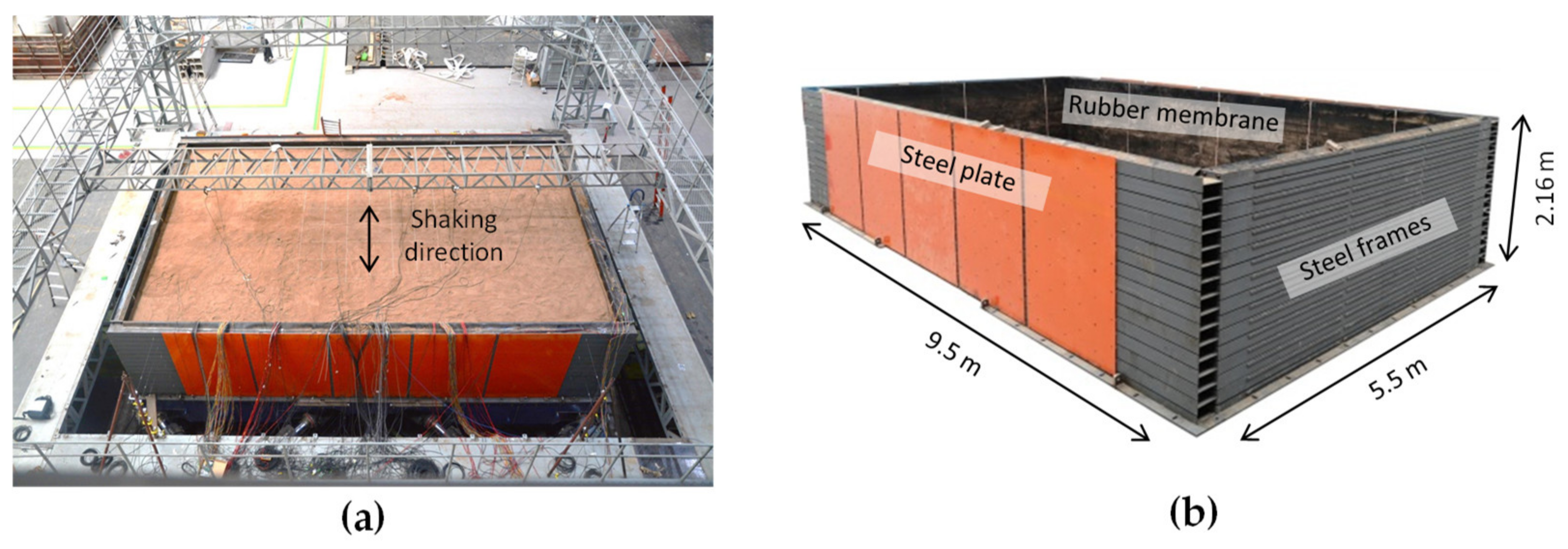
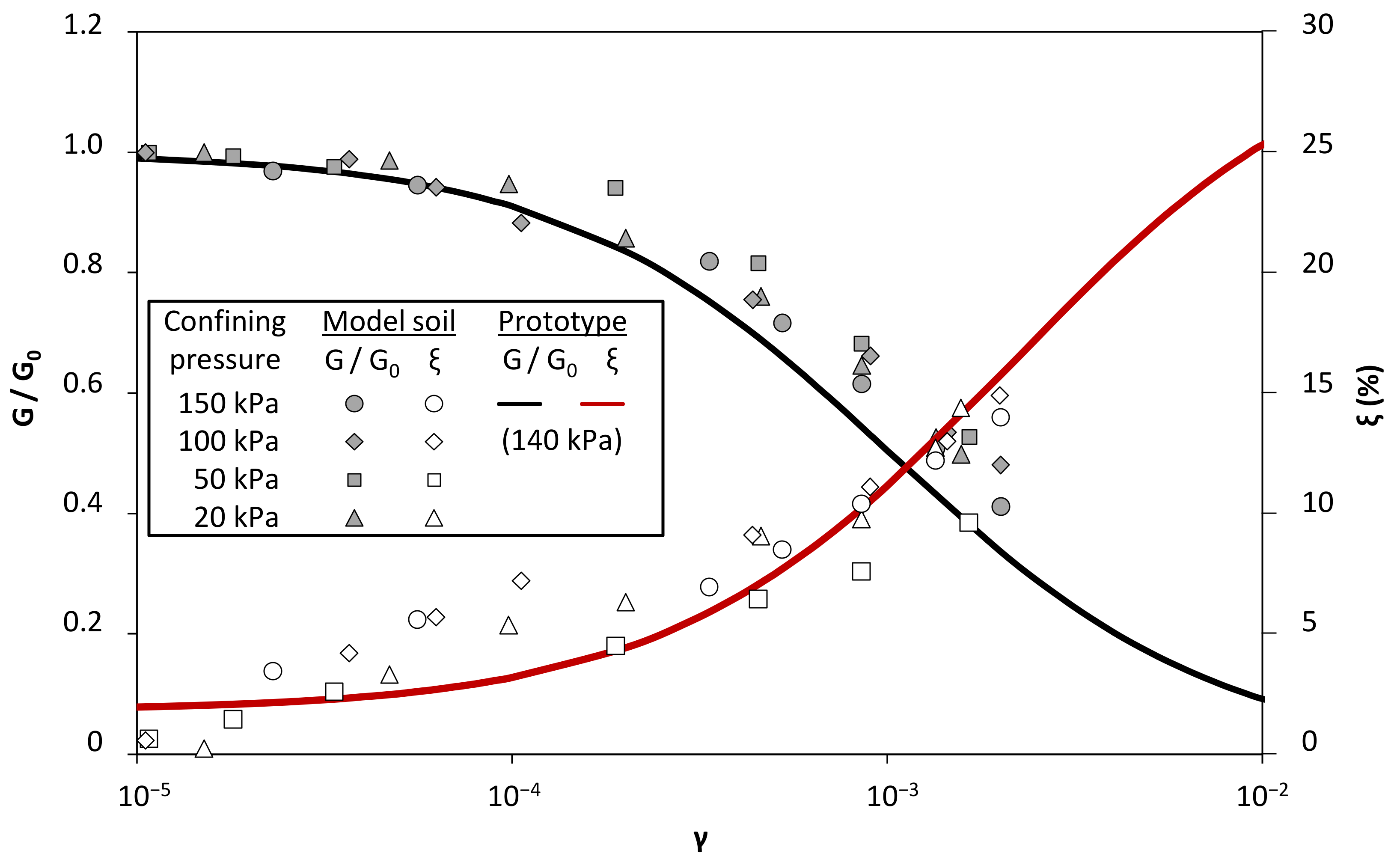

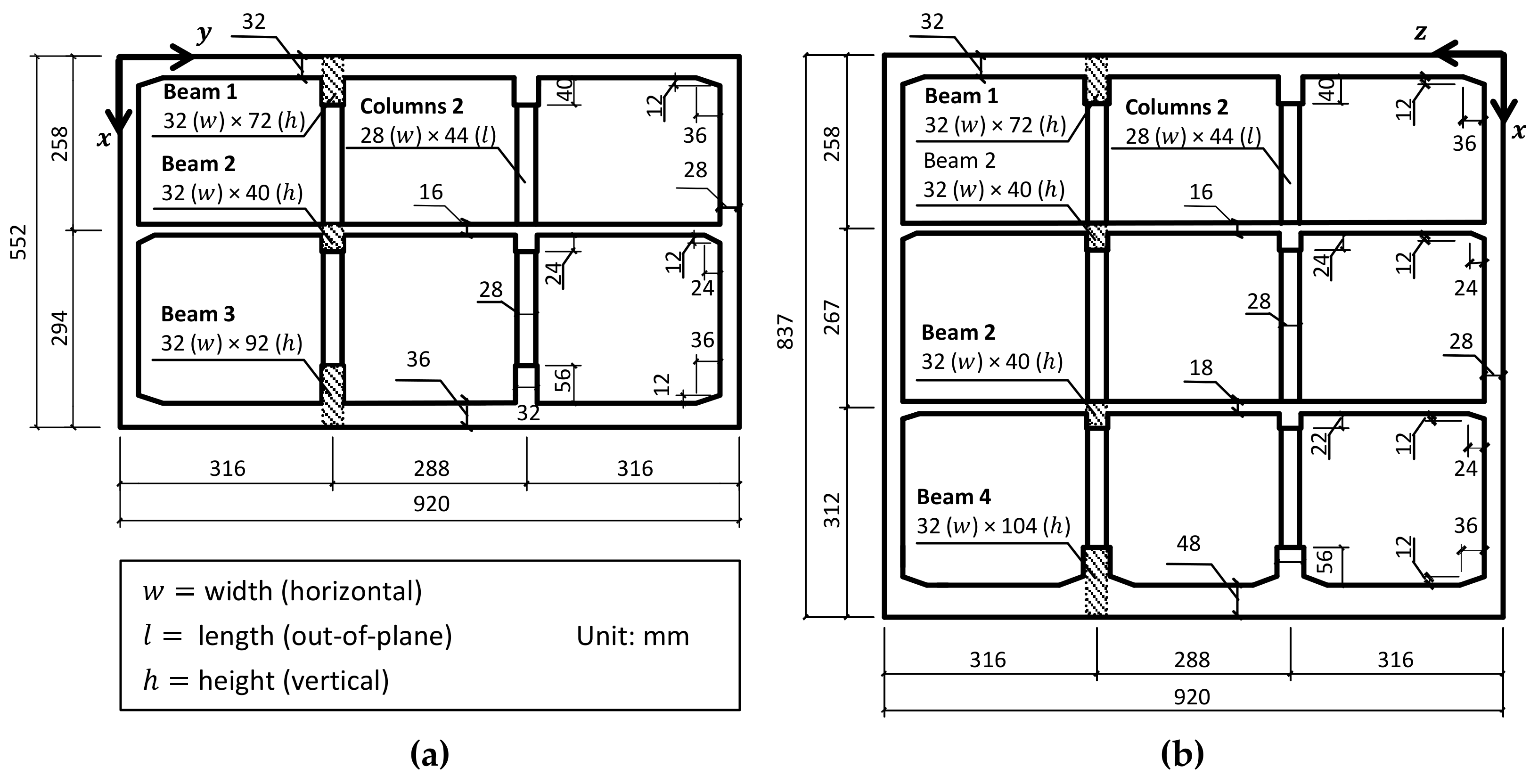
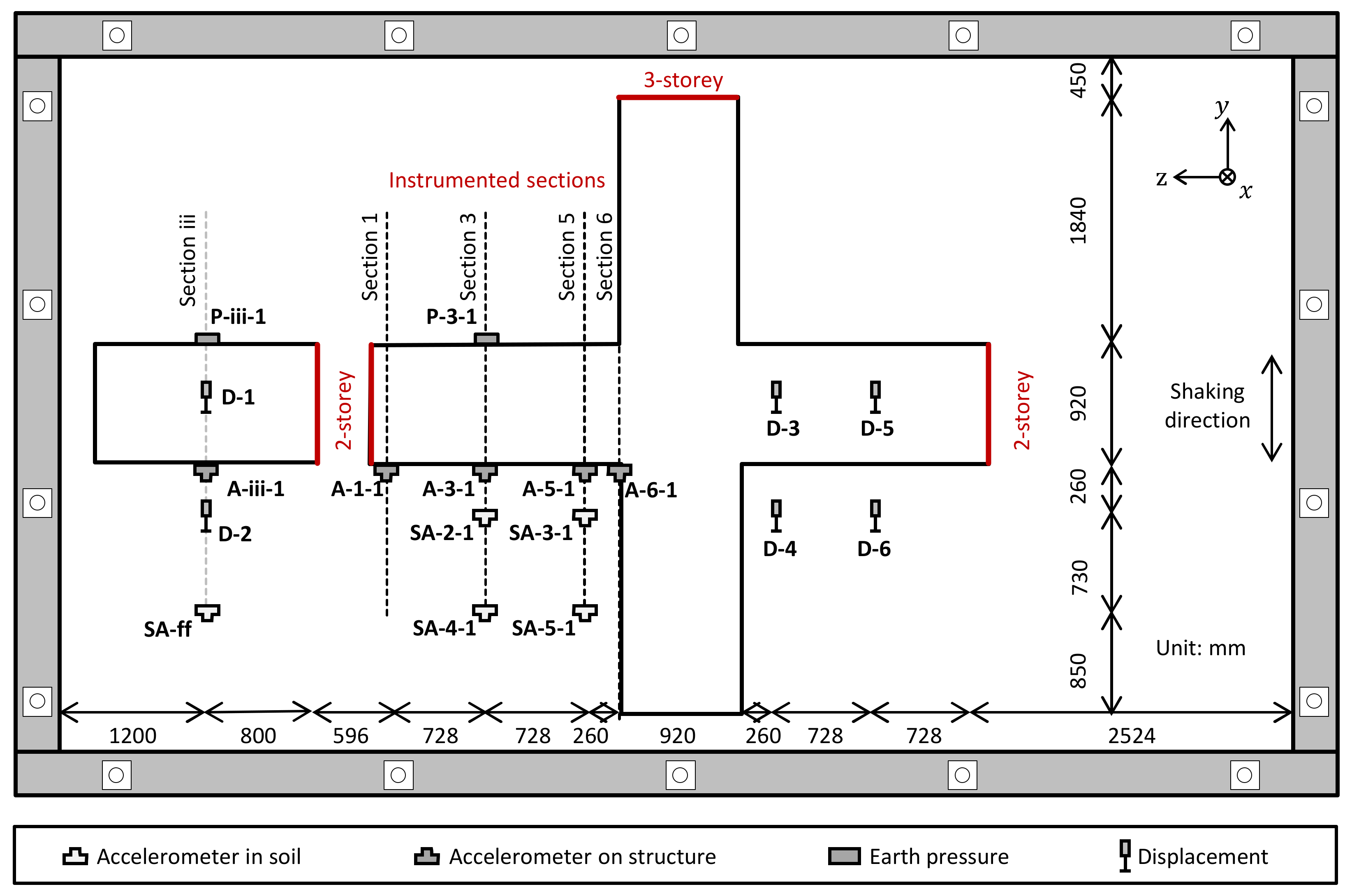
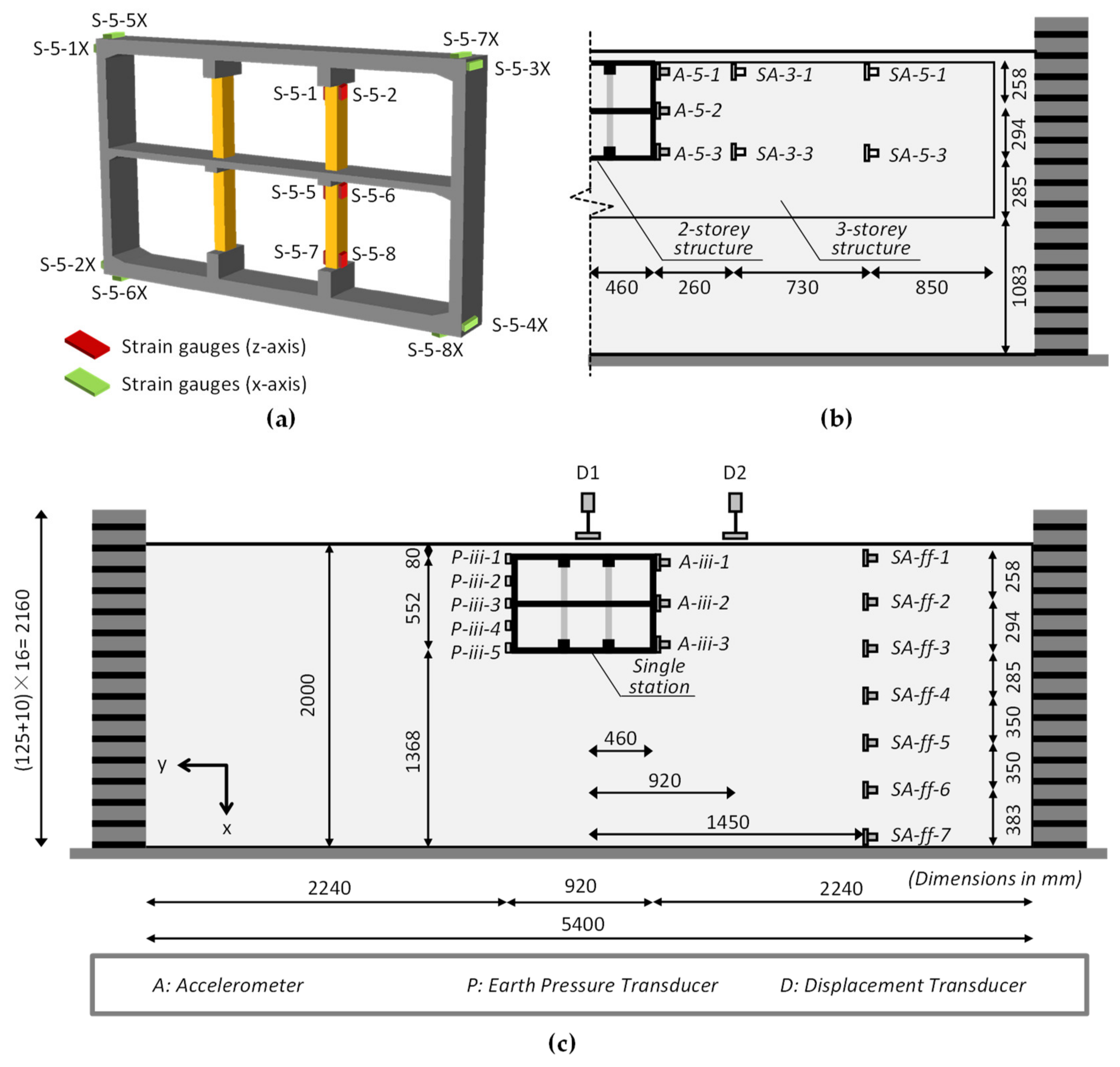

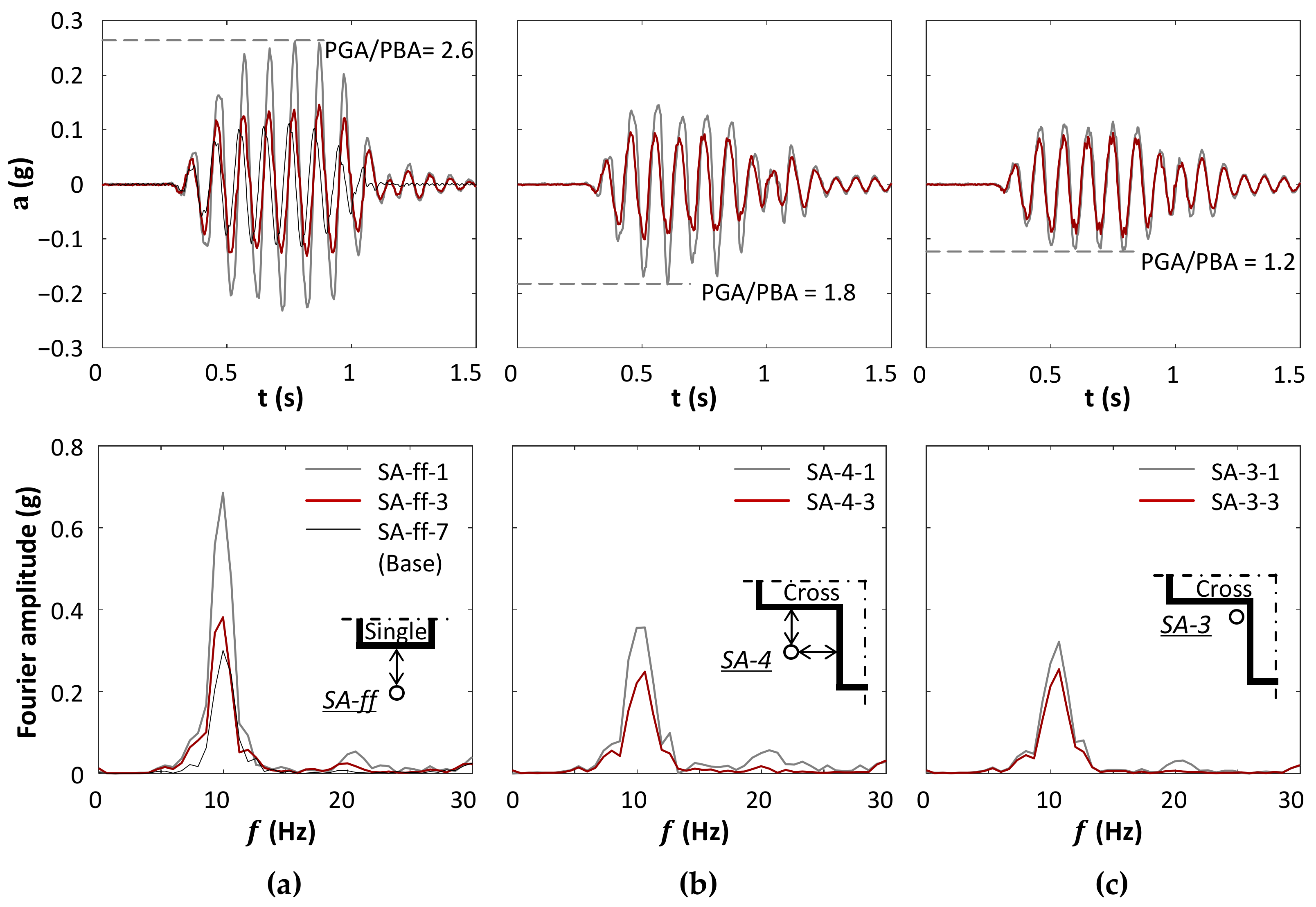
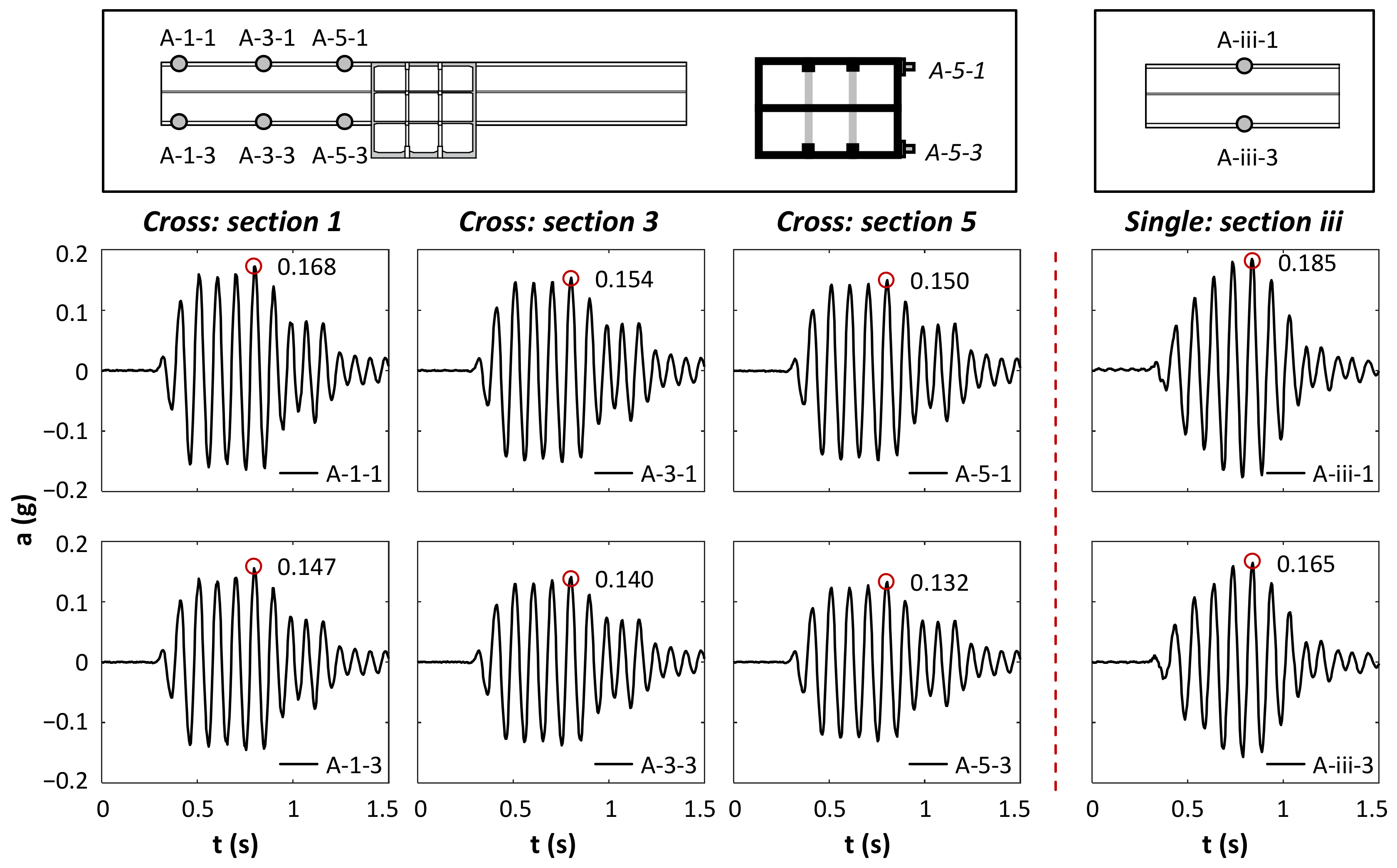

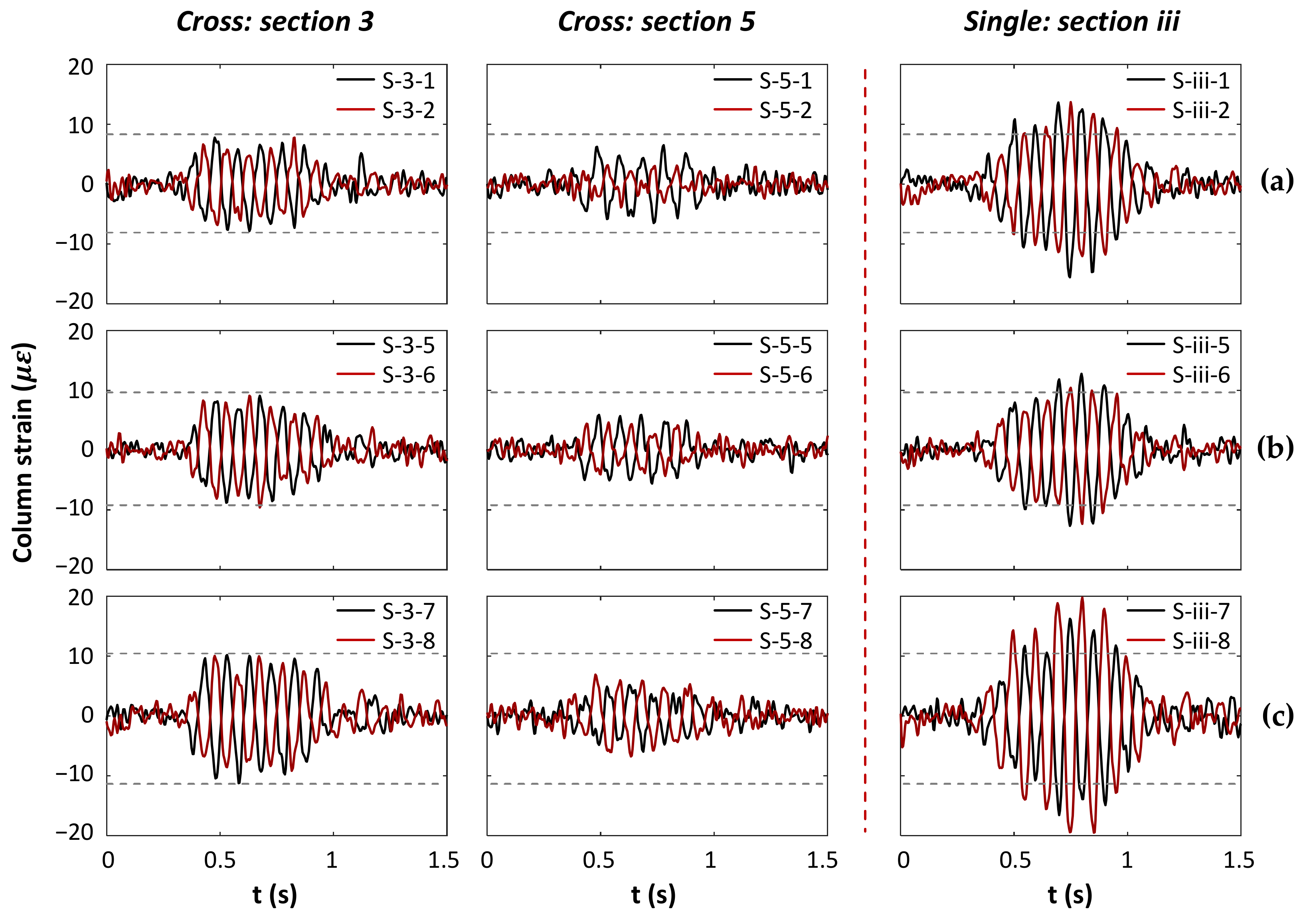
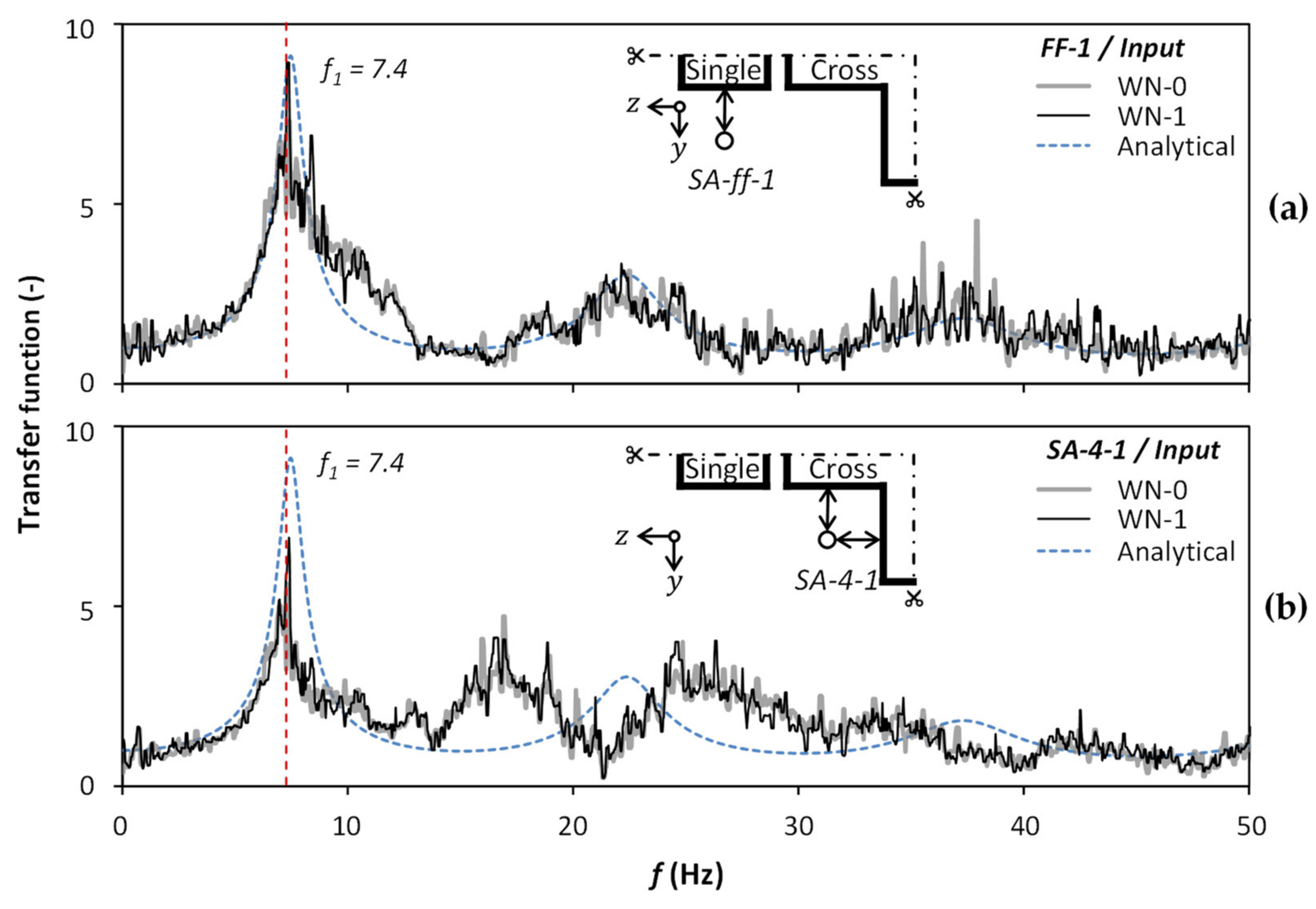
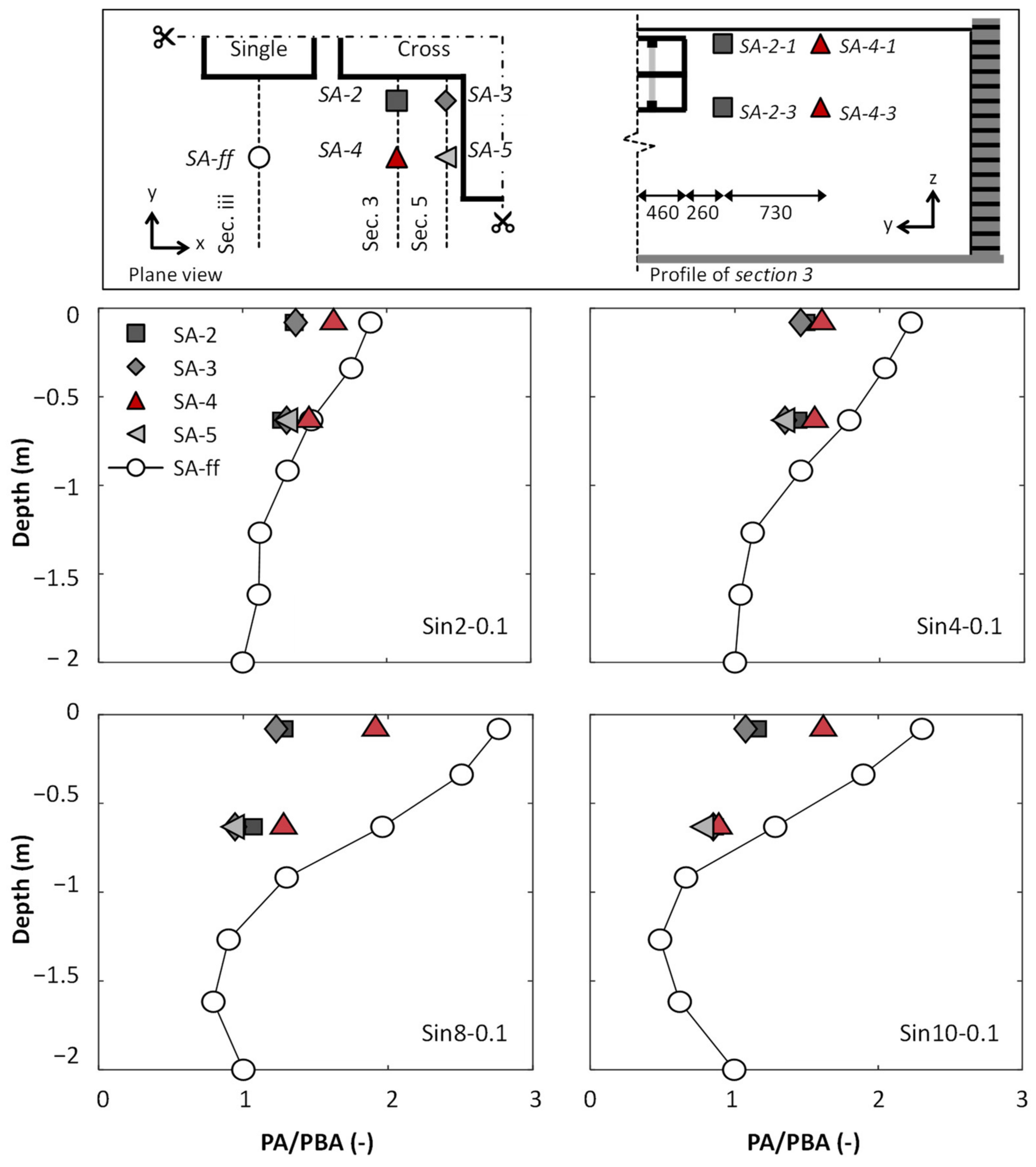
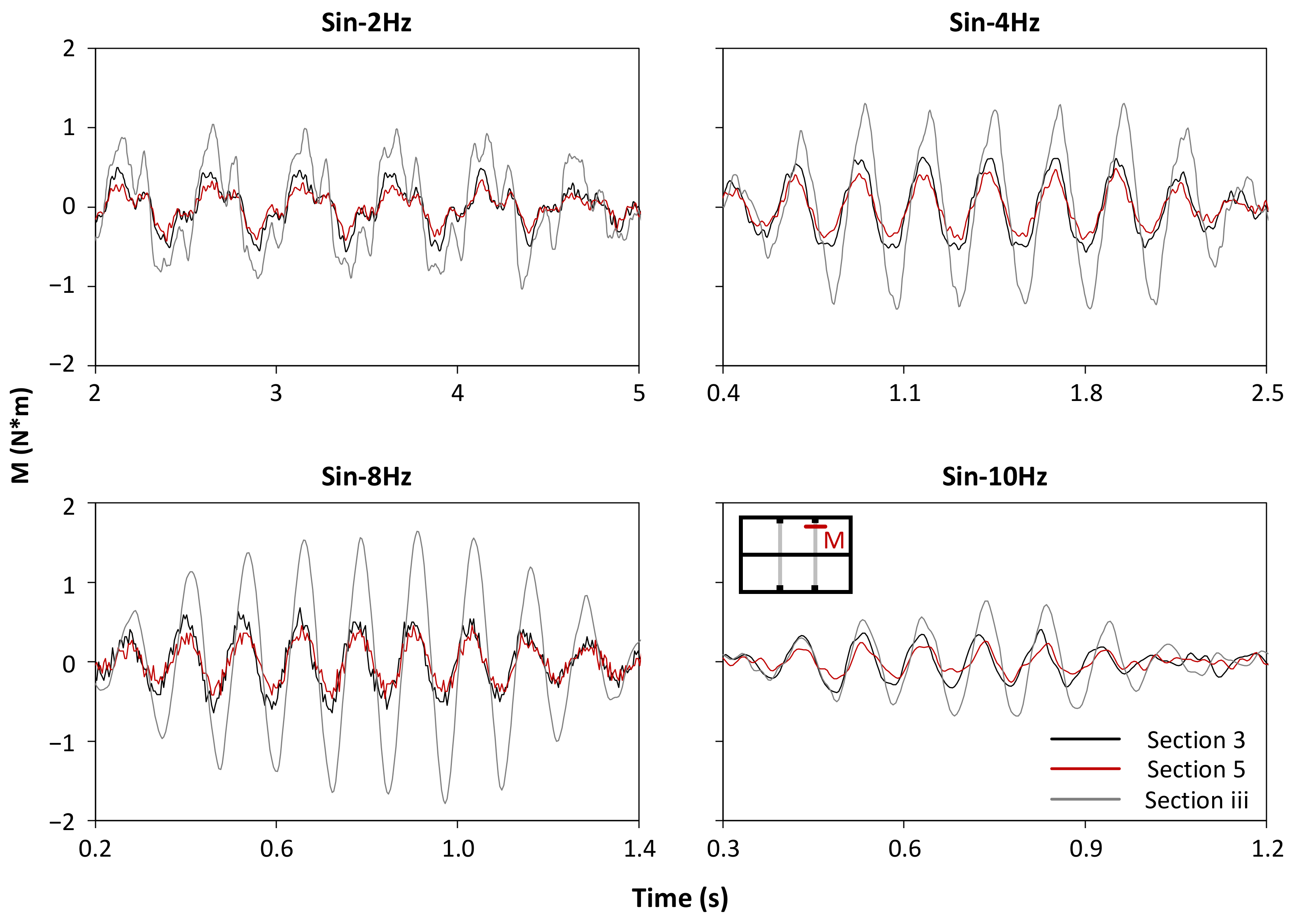
| No. | Soil | Depth (m) | ||||
|---|---|---|---|---|---|---|
| 1 | Fill | 1.9 | 125 | 17.3 | - | - |
| 2 | Silty clay | 3.5 | 128 | 18.5 | - | - |
| 3 | Silty clay | 9.5 | 125 | 17.1 | 4 | 31 |
| 4 | Mud clay | 17.6 | 137 | 16.6 | 3 | 28 |
| 5 | Clay | 23.8 | 189 | 17.4 | 2 | 25 |
| 6 | Silty clay | 30.9 | 235 | 19.4 | 5 | 26 |
| 7 | Sandy silt | 42.8 | 255 | 18.9 | 7 | 33 |
| 8 | Silt | 50 | 322 | 18.9 | - | - |
| Quantity | Similarity Relations | Scale Factor |
|---|---|---|
| Displacement () | 1/25 | |
| Density (ρ) | 1/2 | |
| Shear modulus () | 1/50 | |
| Acceleration (α) | 1 | |
| Time () | 1/5 | |
| Velocity (V) | 1/5 | |
| Shear wave velocity () | 1/5 | |
| Frequency, dynamic () | 5 | |
| Natural frequency () | 5 | |
| Force () | 1/31, 250 |
| Item | (mm) | (kg/m3) | ||
|---|---|---|---|---|
| Steel wire 22 | 0.7 | 7850 | 312 | 205 |
| Steel wire 18 | 1.2 | 7850 | 347 | 205 |
| Fine granular concrete | - | 1860 | 10.6 | 9.6 |
| Earthquake | Year | Test No. | PGA (g) | |
|---|---|---|---|---|
| White noise | - | WN-0 | 0.02 | - |
| Sin-2Hz | - | Sin2-0.1 | 0.1 | 0.09 |
| Sin-4Hz | - | Sin4-0.1 | 0.1 | 0.14 |
| Sin-8Hz | - | Sin8-0.1 | 0.1 | 0.72 |
| Sin-10Hz | - | Sin10-0.1 | 0.1 | 0.17 |
| White noise | - | WN-1 | 0.02 | - |
| Earthquake | Low-Frequency Cutoff (Hz) | High-Frequency Cutoff (Hz) | Frequency Range of Significant Acceleration Response (Hz) |
|---|---|---|---|
| Sin-2Hz | 0.5 | 45 | 1.5–2.5 |
| Sin-4Hz | 1 | 45 | 2.0–7.0 |
| Sin-8Hz | 1 | 45 | 5.5–12.0 |
| Sin-10Hz | 2 | 45 | 6.0–14.5 |
Publisher’s Note: MDPI stays neutral with regard to jurisdictional claims in published maps and institutional affiliations. |
© 2021 by the authors. Licensee MDPI, Basel, Switzerland. This article is an open access article distributed under the terms and conditions of the Creative Commons Attribution (CC BY) license (http://creativecommons.org/licenses/by/4.0/).
Share and Cite
Ge, S.; Wu, W.; Ding, W.; Yuan, Y. Shaking Table Test on the Response of a Cross Interchange Metro Station under Harmonic Excitations Refers to a Single Two-Storey Metro Station. Appl. Sci. 2021, 11, 1551. https://doi.org/10.3390/app11041551
Ge S, Wu W, Ding W, Yuan Y. Shaking Table Test on the Response of a Cross Interchange Metro Station under Harmonic Excitations Refers to a Single Two-Storey Metro Station. Applied Sciences. 2021; 11(4):1551. https://doi.org/10.3390/app11041551
Chicago/Turabian StyleGe, Shiping, Weifeng Wu, Wenqi Ding, and Yong Yuan. 2021. "Shaking Table Test on the Response of a Cross Interchange Metro Station under Harmonic Excitations Refers to a Single Two-Storey Metro Station" Applied Sciences 11, no. 4: 1551. https://doi.org/10.3390/app11041551
APA StyleGe, S., Wu, W., Ding, W., & Yuan, Y. (2021). Shaking Table Test on the Response of a Cross Interchange Metro Station under Harmonic Excitations Refers to a Single Two-Storey Metro Station. Applied Sciences, 11(4), 1551. https://doi.org/10.3390/app11041551






